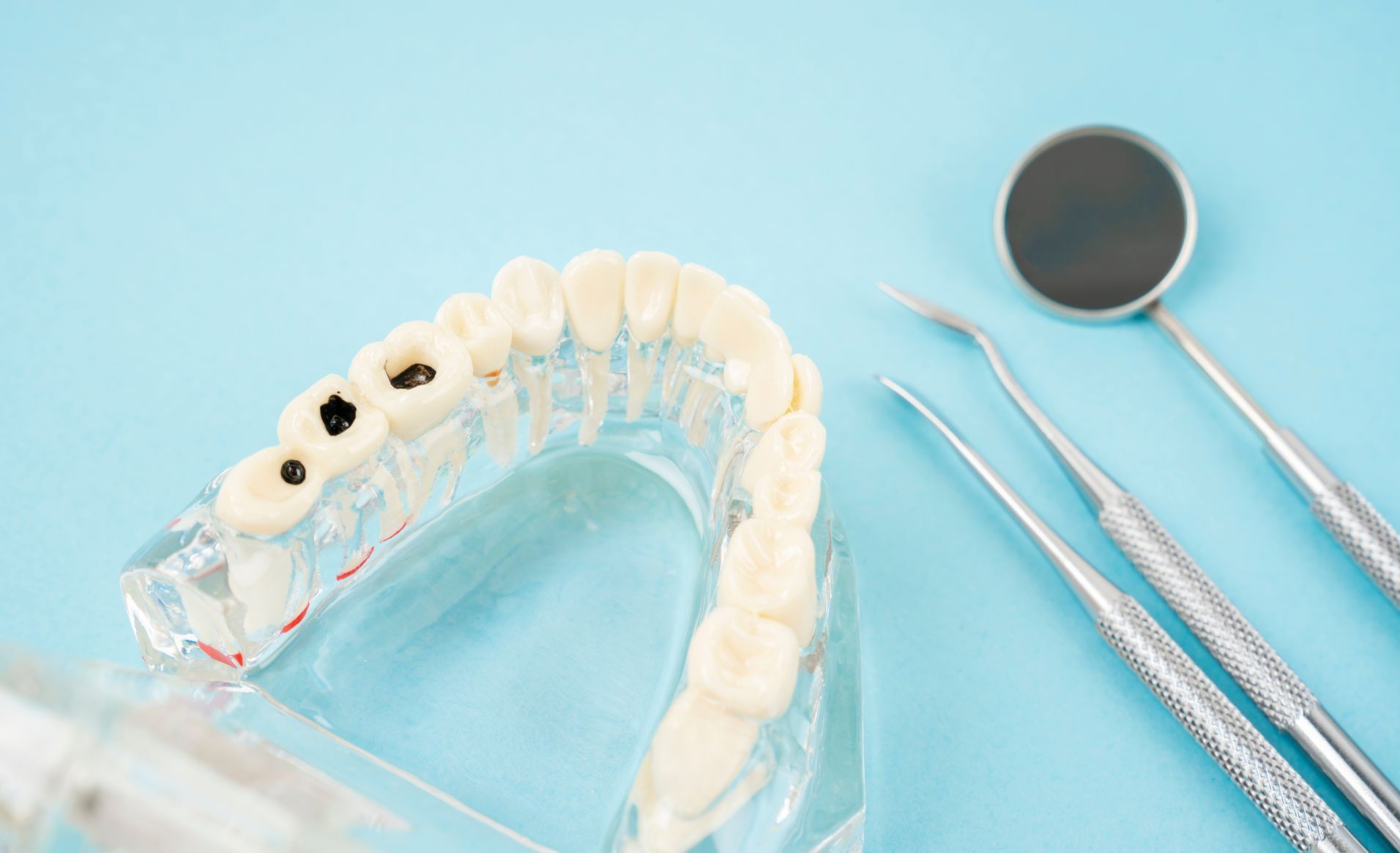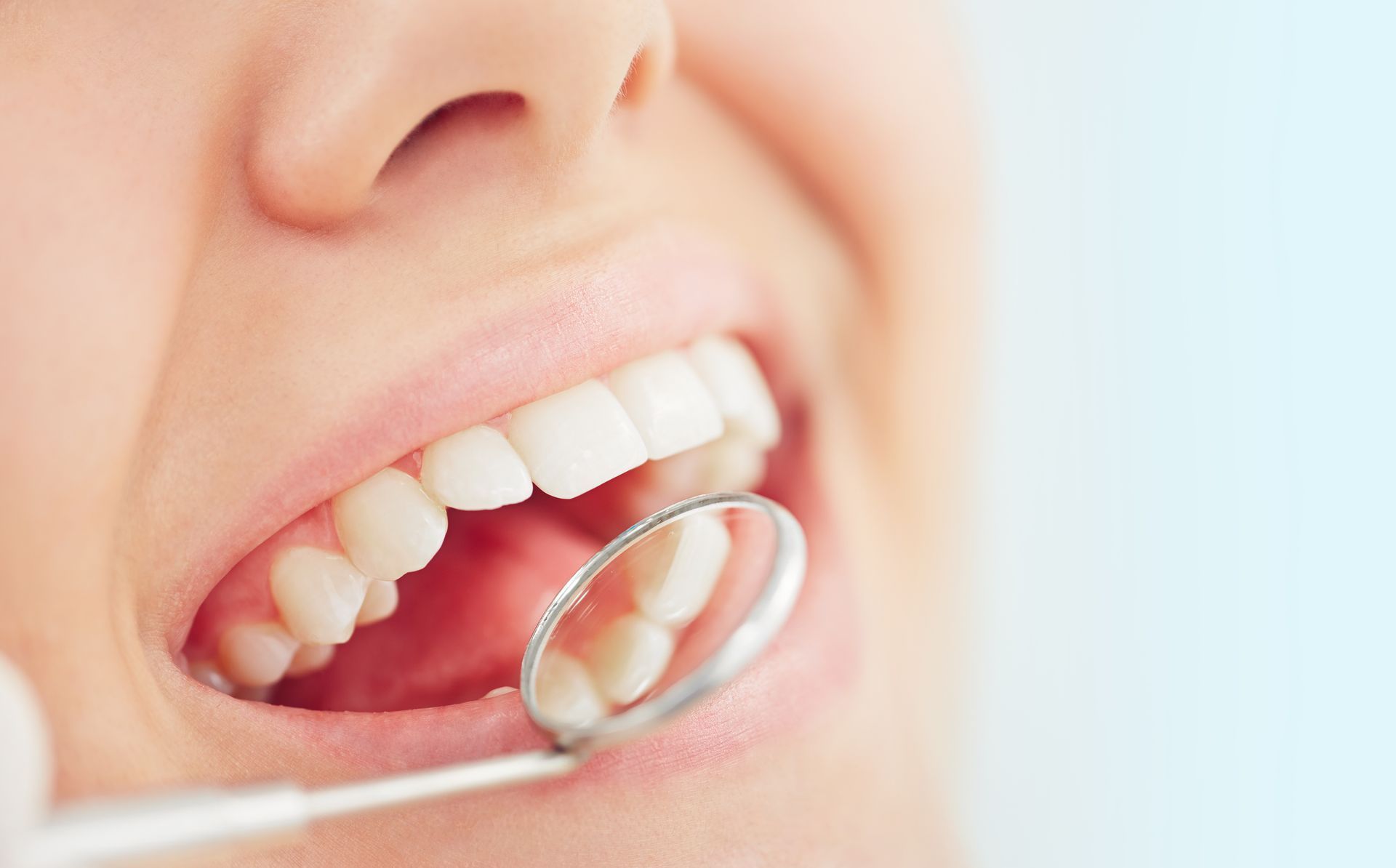Caries
What is Dental Caries?
Dental caries is one of the most common diseases worldwide and affects people of all ages. It is an infectious and multifactorial condition that results in the demineralisation of tooth enamel and the gradual destruction of the tooth's internal structures. Caries lesions are caused by the action of acids produced by bacteria present in plaque, which accumulate on the surface of the teeth.

When we eat foods rich in sugars and starches, the bacteria in the mouth metabolise these carbohydrates, producing acids that damage tooth enamel. If this demineralisation is not stopped, it can progress, causing
defects on the tooth surface that lead to enamel degradation and in more advanced cases to lesions that can affect the dentin and even eventually the dental pulp, leading to painful symptoms and abscesses. Without treatment, this pathology can lead to the loss of the affected tooth and other oral or systemic complications.
Possible Symptoms
The symptoms of tooth caries can vary depending on the extent and location of the caries lesion. Some of the most common symptoms include:
Tooth Sensitivity
An uncomfortable or painful sensation when teeth are exposed to extreme temperatures and/or sweet foods. Sensitivity can indicate that the caries lesion is progressing and affecting the deeper layers of the tooth.
Colour changes on the tooth surface
Brown, black or white spots can appear on the surface of the tooth. These spots are a visible sign of enamel demineralisation and can precede the formation of cavities.
Cavidades Visíveis
Small cavities or fissures may be visible on the surface of the affected tooth. These cavities are the result of the progression of the caries lesion and the loss of tooth structure.
Bad breath
The build-up of plaque, decaying food in cavities and the presence of cavities can contribute to persistent bad breath.
Difficulty in chewing
Pain and sensitivity can make it difficult to chew food normally, leading to a restricted diet and potential nutritional deficiencies.
Tooth Pain
The pain can be continuous or intermittent and is usually triggered by hot, cold or sweet foods and drinks. This pain can vary from mild to severe and can be a sign that the decay has reached the dentin or pulp of the tooth.
Inflamed gums
Some deep caries lesions in the root zones and between teeth can lead to inflammation of the surrounding gum tissue, resulting in swelling and pain of the gums.
Treatments available
The treatment of tooth decay varies according to the extent of the damage and its severity. Here are some of the most common treatments:
Topical Fluoride Application:
Fluoride treatments can help remineralise tooth enamel in the early stages of caries lesions. Fluoride strengthens the enamel and makes it more resistant to the action of acids.
Dental sealants:
Application of a protective resin to the chewing surfaces of teeth to prevent the formation of cavities, especially in children and adolescents.
Direct restorations:
The use of materials such as composite resin or ceramic makes it possible to fill in lost tooth structure resulting from the removal of decay. This procedure restores the tooth's natural form and function.
Crowns:
In cases of extensive decay, where a large part of the tooth's structure is compromised, it may be necessary to cover the tooth with a crown to restore its shape, function and appearance.
Endodontic treatment (devitalisation):
When the caries lesion reaches the dental pulp, it is necessary to remove the infected tissue and seal the root canal. This procedure allows the tooth to be maintained, eliminating pain and infection.
Tooth extraction:
In extreme cases, tooth extraction is necessary whenever the tooth is severely damaged and cannot be restored. After extraction, an implant or bridge may be recommended to replace the lost tooth.
Our Clinical Team is here to help you!
Agreements and partnerships
FAQ's
1. What causes dental caries?
Caries is caused by the action of acids produced by bacteria that feed on sugars in the mouth. Lack of proper oral hygiene and frequent consumption of sugary foods contribute to the development of caries lesions.
2. How can I prevent dental caries?
Maintaining good oral hygiene is essential. Brush your teeth at least twice a day with a fluoridated toothpaste, floss daily, avoid sugary foods and drinks and visit your dentist or oral hygienist regularly.
3. What is the most common treatment for this condition?
The most common treatment is tooth restoration, where the dentist removes the damaged tooth tissue and fills the cavity with a suitable material, such as composite resin. This procedure is effective in restoring the tooth's function and aesthetics.
4. Is the treatment of this condition painful?
Most treatments are carried out under local anaesthetic, which makes the procedure painless. There may be some discomfort after the treatment, but this is usually temporary.
5. Can children also have caries lesions?
Yes, children are especially susceptible to tooth decay due to the frequent consumption of sugary foods and oral hygiene that can sometimes be less than effective. It's important to teach and supervise children's oral hygiene and instil healthy eating habits from an early age, thus preventing the onset of this pathology.
6. What happens if a cavity is left untreated?
If left untreated, this condition progresses and can lead to pain, a dental abscess and eventually tooth loss. If left untreated, dental infections can also spread to other parts of the body and lead to more serious health complications.
7. How often should I visit the dentist to prevent caries?
It is recommended that you visit your oral hygienist or dentist at least twice a year for oral hygiene check-ups and routine examinations. In this way, you can identify and treat problems early, before they become more serious, and help maintain your oral health.
Our Clinical Team is here to help you!







